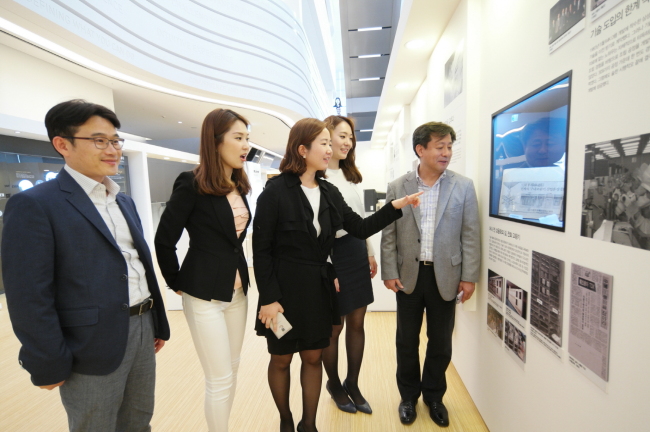A top executive of Samsung Electronics’ visual display business unit said Wednesday that it would further beef up its super ultrahigh-definition TV models rather than its lineup using organic light emitting diodes.
Samsung released premium SUHD TVs earlier this year, which utilize a liquid crystal display coated with a sheet of nanocrystals, or often called quantum dots.
The quantum dots measuring around 3 to 7 nanometers improve color accuracy and color gamut, according to Samsung.
Global TV manufacturers including LG Electronics and Sony are trying to roll out the nanocrystal TVs, which are much more cost effective than other products with advanced display technologies such as OLED.
 |
| Samsung Electronics employees look at displayed materials at the Samsung Innovation Museum in Suwon, Gyeonggi Province. (Samsung Electronics) |
“The nanocrystal technology will continue to evolve and Samsung will surprise the world with new SUHD TV with advanced nanocrystal technology,” said Han Jong-hee, executive vice president of the tech giant’s visual display division, at a media briefing.
He added that the company needed to further work on improving the OLED technology, which is still at a fledgling stage, before mass production in earnest.
The press meeting was held on the sidelines of an event to celebrate the first anniversary of the opening of the Samsung Innovation Museum in Suwon, south of Seoul. The SIM opened on April 21 last year.
“Samsung, which has developed nanocrystal technology since 2002, has now unrivaled capabilities including cadmium-free nanocrystals,” said Han.
Since most other TV-makers have recently started producing TVs with nanocrystals, they may face technological difficulties to maintain stable productivity, he predicted.
The tech giant, meanwhile, said it would hold an exhibition to celebrate the museum’s first anniversary from Thursday through June 19.
Located on Samsung’s Suwon campus, the five-story museum features a variety of historical electronic products including original models of innovations by Thomas Edison and Graham Bell and Samsung’s groundbreaking products, chips and electronics parts since the founding of the firm in 1969.
Items on display at the SIM include Samsung’s first 64K DRAM chip made in 1983 and the world’s first 64M DRAM chip in 1992. Some documents and materials including a handwritten report made by the sitting Samsung vice chairman Kwon Oh-hyun in 1988 will also be displayed at the museum.
By Kim Young-won (wone0102@heraldcorp.com)



